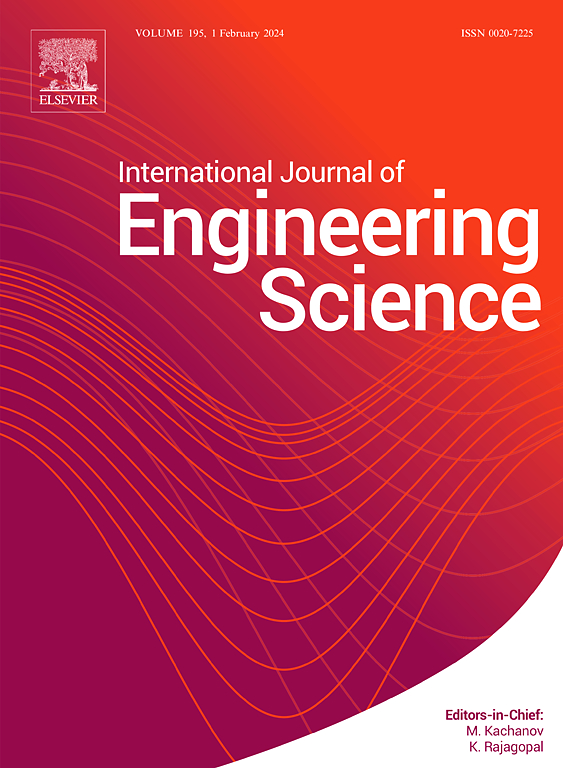几何不亲和性对生长管状软物质形态不稳定性及演化的影响
IF 5.7
1区 工程技术
Q1 ENGINEERING, MULTIDISCIPLINARY
International Journal of Engineering Science
Pub Date : 2025-06-04
DOI:10.1016/j.ijengsci.2025.104308
引用次数: 0
摘要
几何不相容调节形态模式的形成和跨越长度尺度的转变在生长软物质系统中被广泛观察到,并因其广泛的应用而引起了人们的广泛关注。本文通过定量膨胀实验、数值模拟和理论分析,全面研究了几何不相容性对双层管外表面生长诱导图案形成和形态演化的影响。实验和理论结果表明,通过控制几何不相容,不仅可以调节起皱模式,还可以调节关键生长因子。随着几何不相容参数的增大,材料的纵向模态向二维模态转变,再向周向模态转变,导致膨胀起皱失稳的发生。值得注意的是,当几何不相容参数上升到一个临界值时,可以观察到外表面的自发不稳定。图案选择上的形态相图进一步说明几何不亲和性如何通过与厚度比和模量比的耦合影响生长诱导的形态不稳定性。数值结果与实验结果一致,表明几何不相容对屈曲后起皱模式的演化也有显著影响。研究结果不仅为软物质系统形态图案的形成提供了基本的认识,而且为利用自起皱在曲面上制造周期图案开辟了新的途径。本文章由计算机程序翻译,如有差异,请以英文原文为准。
Influence of geometrical incompatibility on morphological instability and evolution of growing tubular soft matter
Geometrical incompatibility regulated morphological pattern formation and transition across length scales are widely observed in growing soft matter systems, and have attracted considerable attentions due to their widespread applications. Here, the influence of geometrical incompatibility on the growth-induced pattern formation and morphological evolution on the outer surface of bilayer tubes is investigated comprehensively, through quantitative swelling experiment, numerical simulation and theoretical analysis. Both experimental and theoretical results demonstrate that not only the wrinkling pattern but also the critical growth factor can be regulated by manipulating geometric incompatibility. An increasing geometrical incompatibility parameter leads to a pattern transition from the longitudinal pattern to 2D pattern and then to circumferential pattern, and brings forward the onset of swelling-induced wrinkling instability. Notably, spontaneous instability can be observed on the outer surface when the geometrical incompatibility parameter rises to a critical value. Morphological phase diagrams on pattern selection further illustrate how geometrical incompatibility influences the growth-induced morphological instability by coupling with the thickness ratio and modulus ratio. In agreement with our experimental observations, the numerical results show that geometrical incompatibility also has a significant influence on the post-buckling evolution of the wrinkling patterns. The results not only provide a fundamental understanding of the morphological pattern formation on soft matter system, but also pave a new avenue for the fabrication of periodic patterns on curved surfaces through self-wrinkling.
求助全文
通过发布文献求助,成功后即可免费获取论文全文。
去求助
来源期刊

International Journal of Engineering Science
工程技术-工程:综合
CiteScore
11.80
自引率
16.70%
发文量
86
审稿时长
45 days
期刊介绍:
The International Journal of Engineering Science is not limited to a specific aspect of science and engineering but is instead devoted to a wide range of subfields in the engineering sciences. While it encourages a broad spectrum of contribution in the engineering sciences, its core interest lies in issues concerning material modeling and response. Articles of interdisciplinary nature are particularly welcome.
The primary goal of the new editors is to maintain high quality of publications. There will be a commitment to expediting the time taken for the publication of the papers. The articles that are sent for reviews will have names of the authors deleted with a view towards enhancing the objectivity and fairness of the review process.
Articles that are devoted to the purely mathematical aspects without a discussion of the physical implications of the results or the consideration of specific examples are discouraged. Articles concerning material science should not be limited merely to a description and recording of observations but should contain theoretical or quantitative discussion of the results.
 求助内容:
求助内容: 应助结果提醒方式:
应助结果提醒方式:


